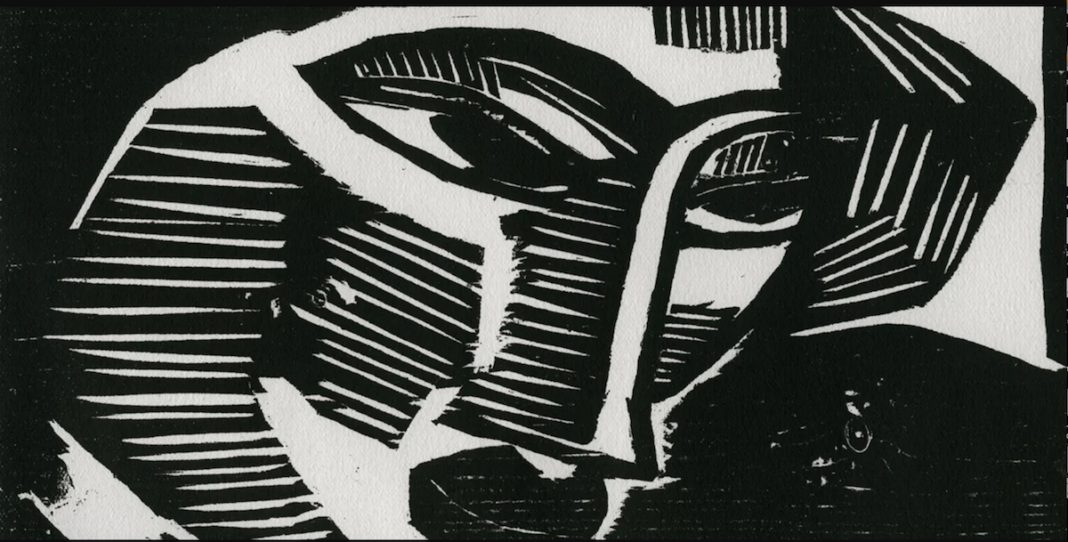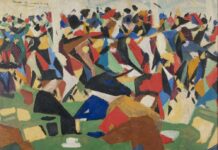German Expressionism: Unveiling the Soul of the Early 20th Century
German Expressionism, a dynamic art movement that emerged in the early 20th century, is a testament to the power of inner emotions over objective reality. This movement, characterized by its bold use of simplified shapes, vivid colors, and expressive brushwork, sought to break free from the constraints of traditional representation. Instead, it delved into the depths of the human psyche, revealing a world of heightened emotions, societal critique, and existential pondering.
One of the defining features of German Expressionism was its departure from the objective portrayal of reality. Artists, in their quest to express their innermost feelings, employed high angles, deep shadows, and chiaroscuro lighting to create an emotional landscape that transcended the boundaries of conventional art. This movement thrived on distorting the visual world to evoke intense moods and provoke viewers to confront their innermost thoughts.
At its core, German Expressionism was driven by a desire to articulate emotional experiences and challenge the prevailing norms of art. In contrast to the detached, intellectualized art of the era, Expressionists focused on the raw and visceral. Through their works, they grappled with the complexities of modern urban life, the solace found in nature and religion, and the primal power of the human body. Their art became a means of confronting the profound changes sweeping society at the time.
Expressionism in Germany was not confined to visual art; it permeated literature, theater, film, and more. It was a holistic movement that aimed to effect profound societal changes, reminding individuals of their inherent humanity. As the movement gained momentum, it extended its reach into politics, economics, social structures, publishing, music, film, and architecture, making it a cultural force that challenged the status quo.
However, German Expressionism was ephemeral, existing in transition and change. Much of its output was printed on cheap paper, and as the National Socialists rose to power in Germany, Expressionism was condemned, destroying many works. Nonetheless, the legacy of German Expressionism endures as a testament to the power of art to reflect and challenge the world it inhabits. This movement continues to inspire and provoke thought, reminding us of the enduring allure of the human spirit in its rawest form.
German Expressionism Artists:
Ernst Ludwig Kirchner, a prominent figure in the Die Brücke movement, produced vibrant and emotionally charged artworks that epitomize the essence of German Expressionism. His paintings, such as “Street, Dresden,” are characterized by bold colors, jagged lines, and distorted figures, conveying a sense of urban anxiety and inner turmoil.
Franz Marc, associated with Der Blaue Reiter, explored spirituality and the connection between humans and nature in his Expressionist art. His masterpiece, “The Large Blue Horses,” is a prime example of his use of vivid, symbolic colors and abstract forms to convey a profound sense of harmony and spiritual unity.
Wassily Kandinsky, another member of Der Blaue Reiter, pushed the boundaries of artistic expression with his abstract works. His painting “Composition VII” is a symphony of colors, shapes, and lines that transcends reality, embodying the movement’s emphasis on inner experiences and emotional expression.
Egon Schiele, known for his raw and provocative art, captured the human form in a deeply expressive and often unsettling manner. His self-portraits and portraits of others, like “Portrait of Wally Neuzil,” are marked by contorted figures and intense psychological insight, reflecting the darker aspects of human existence.
Emil Nolde, a member of Die Brücke and later the Berlin Secession, brought a sense of mysticism to his Expressionist works. His painting “The Prophet” conveys a sense of spiritual ecstasy through bold colors and fluid forms, showcasing Nolde’s unique approach to the movement.
Paul Klee‘s art, influenced by Expressionism, Surrealism, and Cubism, is a testament to his innovative and whimsical style. Works like “Senecio” blend abstraction and childlike imagination, reflecting Klee’s exploration of the inner world and the fantastical.
Otto Dix is renowned for his searing critiques of German society during the Weimar Republic. His series “The War” presents a harrowing depiction of the horrors of World War I, combining graphic realism with Expressionist elements to convey the psychological trauma of war.
Käthe Kollwitz‘s emotionally charged graphic works, such as “The Mothers,” poignantly portray the human condition, particularly the suffering of women and families during times of war and hardship. Her powerful prints and sculptures exemplify the social conscience of German Expressionism.
Erich Heckel, a founding member of Die Brücke, played a pivotal role in the movement. His woodcuts and paintings, like “Roquairol,” often feature stylized, elongated figures in a raw and primitivist style, capturing the essence of urban life and human connection.
Oskar Kokoschka‘s Expressionist portraits, including “Portrait of Alma Mahler,” reveal a profound emotional intensity. His bold use of color and dynamic brushwork convey the inner turmoil and passion of his subjects, reflecting the spirit of the movement.
Max Beckmann‘s art, characterized by its dark and brooding themes, delved into the complexities of human existence. His painting “The Night” is a haunting reflection of the post-war disillusionment and moral decay, a recurrent motif in his Expressionist works.
August Macke, associated with Der Blaue Reiter, infused his works with vibrant colors and a sense of optimism. His painting “Tightrope Walker” exemplifies his playful and joyful approach to depicting life, capturing the movement’s celebration of the human spirit.
Karl Schmidt-Rottluff, a co-founder of Die Brücke, embraced the use of woodcuts and bold, angular forms. His graphic works, like “Two Men” and “Nude,” showcase his knack for distilling the essence of the subject and the emotional intensity of Expressionism.
George Grosz‘s satirical and critical approach to art is evident in works like “Eclipse of the Sun.” His sharp social commentary, often laced with dark humor, reveals the tumultuous times of Weimar Germany and the political turmoil through an Expressionist lens.
Max Pechstein‘s colorful and expressive paintings, such as “Indian and Woman,” reflect his fascination with non-Western art and cultures. His vivid use of color and flattened forms contribute to the movement’s exploration of primitivism and subjectivity.
Gabriele Münter, a key member of Der Blaue Reiter, produced vibrant landscapes and still-life paintings. Her work, like “Jawohl, Blaue Reiter,” radiates a sense of harmony and spirituality, in line with the movement’s ideals.
Alexej von Jawlensky’s portraits, characterized by their colorful abstractions and spiritual depth, are exemplified by works such as “Variation.” His exploration of the human face as a vessel of emotion and inner life aligns with Expressionism’s focus on the subjective.
Anselm Kiefer, although working in a later period, draws inspiration from German Expressionism. His monumental and layered artworks, like “Breaking of the Vessels,” grapple with history, memory, and mythology, reflecting the movement’s ongoing influence.
Georg Baselitz, known for his inverted and often provocative imagery, challenges conventions in his art. His expressive paintings, such as “Big Night Down the Drain,” confront societal norms and explore the depths of the human.
Adolf Harms Verlag Hamburg
Akademischer Verband für Literatur und Musik, Vienna
Josef Albers American, born Germany. 1888–1976
Allianz-Verlag, Zürich
Altershilfe des Deutschen Volkes
Amsler & Ruthardt
Associated American Artists, New York
Avalun Verlag
Julius Bard Verlag, Berlin
Black Sun Press, New York
Buchholz Gallery, New York
Cahiers d’Art, Paris
Carl Reissner Verlag, Dresden
Bruno Cassirer
Paul Cassirer, Berlin
Hyperion Verlag
Cologne Sonderbund
Contemporary Print Group, New York
Friedrich Dehne
Delphin-Verlag, Munich
Deutscher Kunstverein, Berlin
Otto Dix German, 1891–1969
Dresdner Verlag, Dresden
E.A. Seemann, Leipzig
Édition Art d’Aujourd’hui, Boulogne
Éditions Cosmopolites, Paris
Éditions “Cahiers d’Art”, Paris
Elena Gottschalk Verlag, Berlin
Ernst Wasmuth, Berlin
Eugen Rentsch Verlag, Zurich
Euphorion Verlag, Berlin
Lyonel Feininger American, 1871–1956
Alfred Flechtheim
Editions Fourcade, Paris
Frankfurter Kunstverein
Freie Secession
Adolph Fürstner
Galerie Ferdinand Möller
Galerie Goldschmidt and Wallerstein, Berlin
Galerie Goyert
O. W. Gauss
Genossenschaft Pan GmbH, Berlin
George Weidenfeld & Nicolson, London
Gerlach & Wiedling, Vienna and Leipzig
Gesellschaft der Erfurter Museumsfreunde, Erfurt
Gesellschaft für vervielfältigende Kunst
Editions Girsberger, Zurich
Hans Goltz
Goltzverlag, Munich
Graphik-Verlag Heinrich Mock
Graphik Verlag München GmbH
Graphisches Kabinett J. B. Neumann
Grillen-Presse, Hamburg
Fritz Gurlitt
Hans Heinrich Tilgner Verlag, Berlin
Hauswedell & Co.
Stanley William Hayter British, 1901–1988
Erich Heckel German, 1883–1970
Heinrich Böhme Verlag, Hannover
Heinrich F.S. Bachmair
Walter Helbig German, 1878–1968
Verlag Jakob Hermelin, Ulm
S. Hirzel, Leipzig
Hochstimm Verlag, Berlin
Dr. Karl Hoenn
Rudolf Hoffmann German, 1882–1941
Horen Verlag, Berlin-Grunewald
Insel
Izo NKP, Moscow
Franz Maria Jansen German, 1885–1958
Johannes Presse, Vienna
Kandinsky-Gesellschaft, Braunschweig
Kastner & Lossen
Kentaur Verlag
Kestner-Gesellschaft, Hannover
Verlag Gustav Kiepenheuer
Paul Klee German, born Switzerland. 1879–1940
Max Klinger German, 1857–1920
Klinkhardt & Biermann, Leipzig
Komitee “Künstlerhilfe” der “Internationalen Arbeiterhilfe,” Berlin
Kreis der Freunde des Bauhauses
Kunsthütte Chemnitz, Chemnitz
Künstlergruppe Brücke, Dresden
Künstlergruppe Brücke, Berlin
Künstlerspende für das deutsche Buchmuseum, Leipzig
Kunstverein für die Rheinlande und Westfalen
Verlag Karl Lang, Darmstadt
The Limited Editions Club, New York
Malik-Verlag, Berlin
Gerhard Marcks German, 1889–1981
Marées-Gesellschaft, R. Piper & Co., Munich
Marlborough Fine Art Ltd., London
Marlborough Graphics Ltd., London
Maximilian-Presse, Hamburg
Paul Mehnert
A. R. Meyer, Berlin-Wilmersdorf
Mourlot, Paris
Otto Mueller German, 1874–1930
Müller & Co. Verlag, Potsdam
Georg Müller Verlag, Munich
Edvard Munch Norwegian, 1863–1944
Münchener Neue Secession
Nassauischer Kunstverein, Neues Museum Wiesbaden
Neue Künstlervereinigung München
Neuland-Verlag
J. B. Neumann
New Directions Books, New York
Wilhelm Niemeyer, Hamburg German
Karl Nierendorf
Emil Nolde German, 1867–1956
November Verlag, Kiel
Éditions Orobitz et Cie., Paris
J. J. Ottens
Pan-Presse (Verlag Paul Cassirer)
Max Pechstein German, 1881–1955
R. Piper & Co., Munich
Propyläen-Verlag, Berlin
Querschnitt Verlag, Frankfurt am Main
Ernest Rathenau
Revista Acadêmico Editora, Rio de Janeiro
Emil Richter
Rikola Verlag, Verlag Neuer Graphik, Vienna
Ludwig Schames, Frankfurt
Rosa Schapire German
Heinar Schilling
Schlesischer Künstlerbund, Breslau
Schweizerische Graphische Gesellschaft
Sirius-Verlag, Zurich
Staatliches Bauhaus, Weimar
Theodor Stroefer
Stroganov Academy
Tendances Nouvelles
E. W. Tieffenbach
Tribune Company, Chicago, Illinois
Wilhelm Uhde, Burg Lauenstein, Oberfranken
Universal Limited Art Editions, West Islip, New York
unpublished
Utopia-Verlag, Weimar
Curt Valentin German, 1902–1954
Verbindung für historische Kunst
Verbindung zur Förderung deutscher Kunst, Berlin
Vereinigung bildender Künstler Österreichs
Verlag Arndt Beyer, Leipzig
Verlag der Dichtung, Potsdam
Verlag der Gäste, Kattowitz
Verlag der Münster-Presse
Verlag Der Sturm, Berlin
Verlag der Wochenschrift DIE AKTION
Verlage des Kreises Graphischer Künstler und Sammler, Arndt Beyer, Leipzig
Verlag Graphisches Kabinett Günther Franke, Munich
Verlag neue Jugend, Berlin
Verlag Neue Kunsthandlung, Berlin
Verlag Neue Kunst Hans Goltz
Verlag der Aufbruch, Kurt Virnerburg, Berlin
Alexander von der Becke, Verlag des graphischen Werkes von Käthe Kollwitz
Verlag von Grethlein & Co., Zürich/Leipzig
Werbedienst der deutschen Republik
Wiener Verlag, Vienna
Wiener Werkstätte, Vienna
J.E. Wolfensberger, Zurich
Kurt Wolff Verlag
Peter Zingler’s Kabinett, Frankfurt













